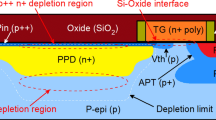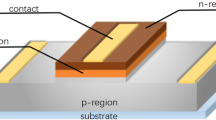Abstract
In0.53Ga0.47As PIN photodetectors were fabricated and their dark currents were measured. Based on the analysis of different mechanisms, a complete dark current model considering trap-assisted tunneling (TAT) mechanism under low and intermediate reverse bias is constructed by studying the electric fields and carrier generation-recombination rates. The obtained current–voltage experimental results under dark conditions are in good agreement with our simulation using this complete model. The contribution of each mechanism is investigated, and to evaluate the dominant factor deriving from Shockley–Read–Hall generation or TAT, a critical voltage (\(V_{cri}\)) where \(I_{TAT} = I_{SRH} \approx 0.5I_{dark}\) is proposed. In addition, the effects of thickness and doping concentration of absorption layer on \(V_{cri}\) are discussed in detail, from which we demonstrate that \(I_{TAT}\) is the dominant component of dark current for those photodetectors operating under the reverse bias of 5 V if the thickness of absorption layer is less than 1 μm when the doping concentration is 1 × 1015 cm−3, or the doping concentration of absorption layer is more than 7 × 1015 cm−3 when the thickness is 2 μm. The effect of temperature on dark current due to TAT is also analyzed.







Similar content being viewed by others
References
Arshad, T.S.M., Othman, M.A., Yasin, N.Y.M., Taib, S.N., Ismail, M.M., Napiah, Z.A.F.M., et al.: Comparison on IV characteristics analysis between Silicon and InGaAs PIN photodiode. In: International Conference on Instrumentation, Communications, Information Technology, and Biomedical Engineering. IEEE (2014). https://doi.org/10.1109/ICICI-BME.2013.6698467
Atlas User’s Manual. SILVACO International (2010)
Chang, S.H., Fang, Y.K., Ting, S.F., Chen, S.F., Lin, C.Y., Wu, C.Y.: Ultra high performance planar InGaAs PIN photodiodes for high speed optical fiber communication. Sens. Actuators A (2007). https://doi.org/10.1016/j.sna.2006.04.023
Chen, B., Yuan Jr., J., Holmes, A.L.: Dark current modeling of InP based SWIR and MWIR InGaAs/GaAsSb type-II MQW photodiodes. Opt. Quantum Electron. (2013). https://doi.org/10.1007/s11082-012-9624-6
Downs, C., Vandervelde, T.E.: Progress in infrared photodetectors since 2000. Sensors (2013). https://doi.org/10.3390/s130405054
Forrest, S.R.: Performance of InxGa1−xAsyP1−y photodiodes with dark current limited by diffusion, generation recombination, and tunneling. IEEE J. Quantum Electron. 17(2), 217–226 (1981)
Forrest, S.R., Leheny, R.F., Nahory, R.E., Pollack, M.A.: In0.53Ga0.47As photodiodes with dark current limited by generation-recombination and tunneling. Appl. Phys. Lett. (1980). https://doi.org/10.1063/1.91922
Hall, R.N.: Electron-hole recombination in germanium. Proc. Phys. Soc. (1952). https://doi.org/10.1103/PhysRev.87.387
Hoogeveen, R.W.M., Ronald, J.V.D.A., Goede, A.P.H.: Extended wavelength InGaAs infrared (1.0–2.4 μm) detector arrays on sciamachy for space-based spectrometry of the earth atmosphere. Infrared Phys. Technol. (2001). https://doi.org/10.1016/S1350-4495(00)00061-X
Hurkx, G.A.M., Klaassen, D.B.M., Knuvers, M.P.G., O'hara, F.G.: A new recombination model describing heavy-doping effects and low-temperature behaviour[C]. In Electron Devices Meeting, 1989. IEDM '89. Technical Digest. International, pp. 307–310. IEEE (1989)
Ishimura, E., Kimura, T., Shiba, T., Mihashi, Y., Namizaki, H.: Dark current and diffusion length in InGaAs photodiodes grown on GaAs substrates. Appl. Phys. Lett. (1990). https://doi.org/10.1063/1.102724
Ji, X., Liu, B., Xu, Y., Tang, H., Li, X., Gong, H.M., et al.: Deep-level traps induced dark currents in extended wavelength InxGa1−xAs/InP photodetector. J. Appl. Phys. (2013). https://doi.org/10.1063/1.4838041
Ji, X., Liu, B., Tang, H., Yang, X., Li, X., Gong, H.M., et al.: 2.6 μm MBE grown InGaAs detectors with dark current of SRH and TAT. AIP Adv. (2014). https://doi.org/10.1063/1.4894142
Jiang, X., Itzler, M.A., Ben-Michael, R., Slomkowski, K.: InGaAsP–InP avalanche photodiodes for single photon detection. IEEE J. Sel. Top. Quantum Electron. (2007). https://doi.org/10.1109/JSTQE.2007.903001
Kosa, A., Stuchlíkova, L., Harmatha, L., Kovac, J., Badura, M., Bielak, K., Tlaczala: DLTFS study of InGaAs/AlInAs heterostructures grown on n-InP: S substrates. In: 11th International Conference on Advanced Semiconductor Devices & Microsystems (ASDAM). IEEE (2016). https://doi.org/10.1109/ASDAM.2016.7805917
Kowalczyk, A.E., Ornoch, L., Muszalski, J., Kaniewski, J.: Deep centers in InGaAs/InP layers grown by molecular beam epitaxy. Opt. Appl. 35(4), 457–463 (2005)
Linga, K.R., Olsen, G.H., Ban, V.S., Joshi, A.N., Kosonocky, W.F.: Dark current analysis and characterization of InxGa1−xAs/InAsyP1−y graded photodiodes with x > 0.53 for response to longer wavelengths (> 1.7 μm). J. Lightwave Technol. (1992). https://doi.org/10.1109/50.156844
Mitsubishi Electric. http://www.mitsubishielectric-mesh.com/products/guang/info/pdto/2_5gbu.php
Noh, I., Noh, H., Kim, Y., Lee, K., Yang, K.: A novel deep guard-ring InGaAs PIN photodiode structure reducing a crosstalk in SWIR imaging detection. In: Compound Semiconductor Week. IEEE (2016). https://doi.org/10.1109/ICIPRM.2016.7528622
Olsen, G.H., Joshi, A.M., Ban, V.S., Woodruff, K.M., Gasparian, G.A., Lange, M.J, Forrest, S.R.: Multiplexed 256 element InGaAs detector arrays for 0.8–1.7 μm room-temperature operation. In: International Society for Optics and Photonics 32nd Annual Technical Symposium (1988). https://doi.org/10.1117/12.948311
Onat, B.M., Masaun, N., Ettenberg, M.H., Dries, C.: Ultra-low dark current InGaAs technology for focal plane arrays for low-light level visible-shortwave infrared imaging. In: International Society for Optics and Photonics Defense and Security Symposium (2007). https://doi.org/10.1117/12.720522
Onat, B.M., Jiang, X., Itzler, M. (2009). A systematic approach to dark current reduction in InGaAs-based photodiode arrays for shortwave infrared imaging. In: Leos Meeting Conference Proceedings, Leos ‘09. IEEE, pp. 231–232. IEEE
Parks, J.W., Smith, A.W., Brennan, K.F., Tarof, L.E.: Theoretical study of device sensitivity and gain saturation of separate absorption, grading, charge, and multiplication InP/InGaAs avalanche photodiodes. IEEE Trans. Electron Devices (1996). https://doi.org/10.1109/16.544382
Philippe, P., Poulain, P., Kazmierski, K., De Cremoux, B.: Dark-current and capacitance analysis of InGaAs/InP photodiodes grown by metalorganic chemical vapor deposition. J. Appl. Phys. (1986). https://doi.org/10.1063/1.336447
Shen, S.C.: Comparison and competition between MCT and QW structure material for use in IR detectors. Microelectron. J. 25(8), 713–739 (1994)
Shockley, W., Read, W.T.: Statistics of the recombinations of holes and electrons. Phys. Rev. (1952). https://doi.org/10.1103/PhysRev.87.835
Trommer, R., Albrecht, H.: Confirmation of tunneling current via traps by DLTS measurements in InGaAs photodiodes. Jpn. J. Appl. Phys. (1983). https://doi.org/10.1143/JJAP.22.L364
Vallone, M., Mandurrino, M., Goano, M., Bertazzi, F., Ghione, G., Schirmacher, W., et al.: Numerical modeling of SRH and tunneling mechanisms in high-operating-temperature MWIR HgCdTe photodetectors. J. Electron. Mater. (2015). https://doi.org/10.1007/s11664-015-3767-8
Wang, X.D., Hu, W.D., Chen, X.S., Lu, W., Tang, H.J., Li, T., et al.: Dark current simulation of Inp/In0.53Ga0.47As/Inp p–i–n photodiode. Opt. Quantum Electron. (2008). https://doi.org/10.1109/NUSOD.2008.4668227
Wang, Y.S., Chang, S.J., Tsai, C.L., Wu, M.C.: High-speed InGaAs P–I–N photodetector with planar buried heterostructure. IEEE Trans. Electron Devices (2009). https://doi.org/10.1109/TED.2009.2018170
Zeng, Q.Y., Wang, W.J., Wen, J., Xu, P.X., Hu, W.D., Li, Q., et al.: Dependence of dark current on carrier lifetime for InGaAs/InP avalanche photodiodes. Opt. Quantum Electron. (2015). https://doi.org/10.1007/s11082-014-0024-y
Acknowledgements
This work was supported by National Nature Science Foundation of China (NSFC) (61574019, 61674018, 61674020), the Fund of State Key Laboratory of Information Photonics and Optical Communications and the Specialized Research Fund for the Doctoral Program of Higher Education of China (20130005130001).
Author information
Authors and Affiliations
Corresponding author
Rights and permissions
About this article
Cite this article
Ma, X., Huang, Y., Fei, J. et al. Analysis of dark current considering trap-assisted tunneling mechanism for InGaAs PIN photodetectors. Opt Quant Electron 49, 407 (2017). https://doi.org/10.1007/s11082-017-1242-x
Received:
Accepted:
Published:
DOI: https://doi.org/10.1007/s11082-017-1242-x




